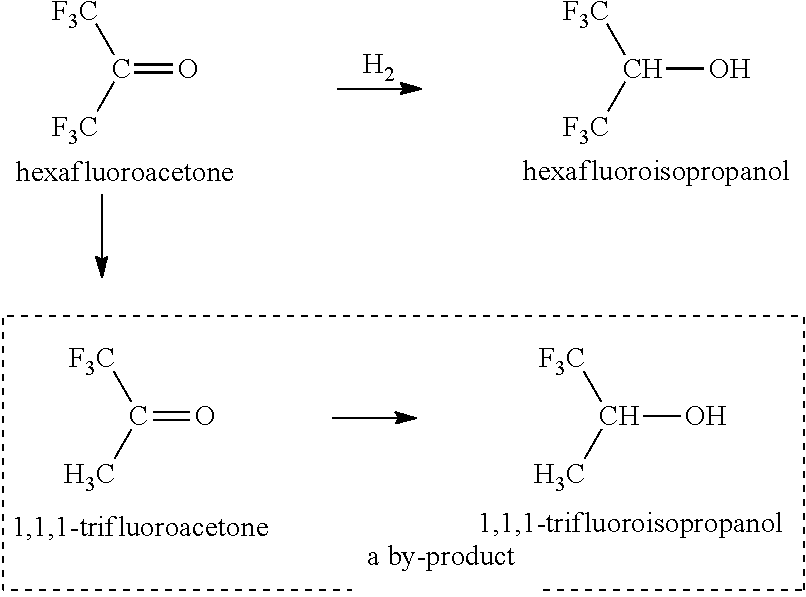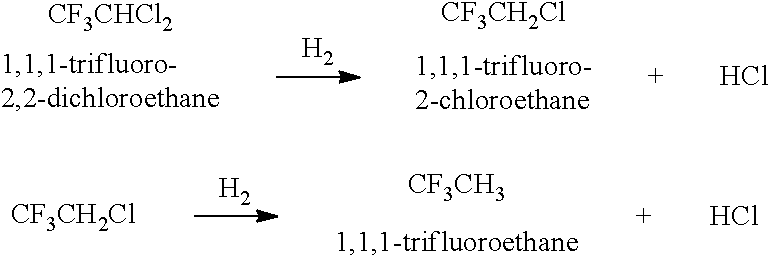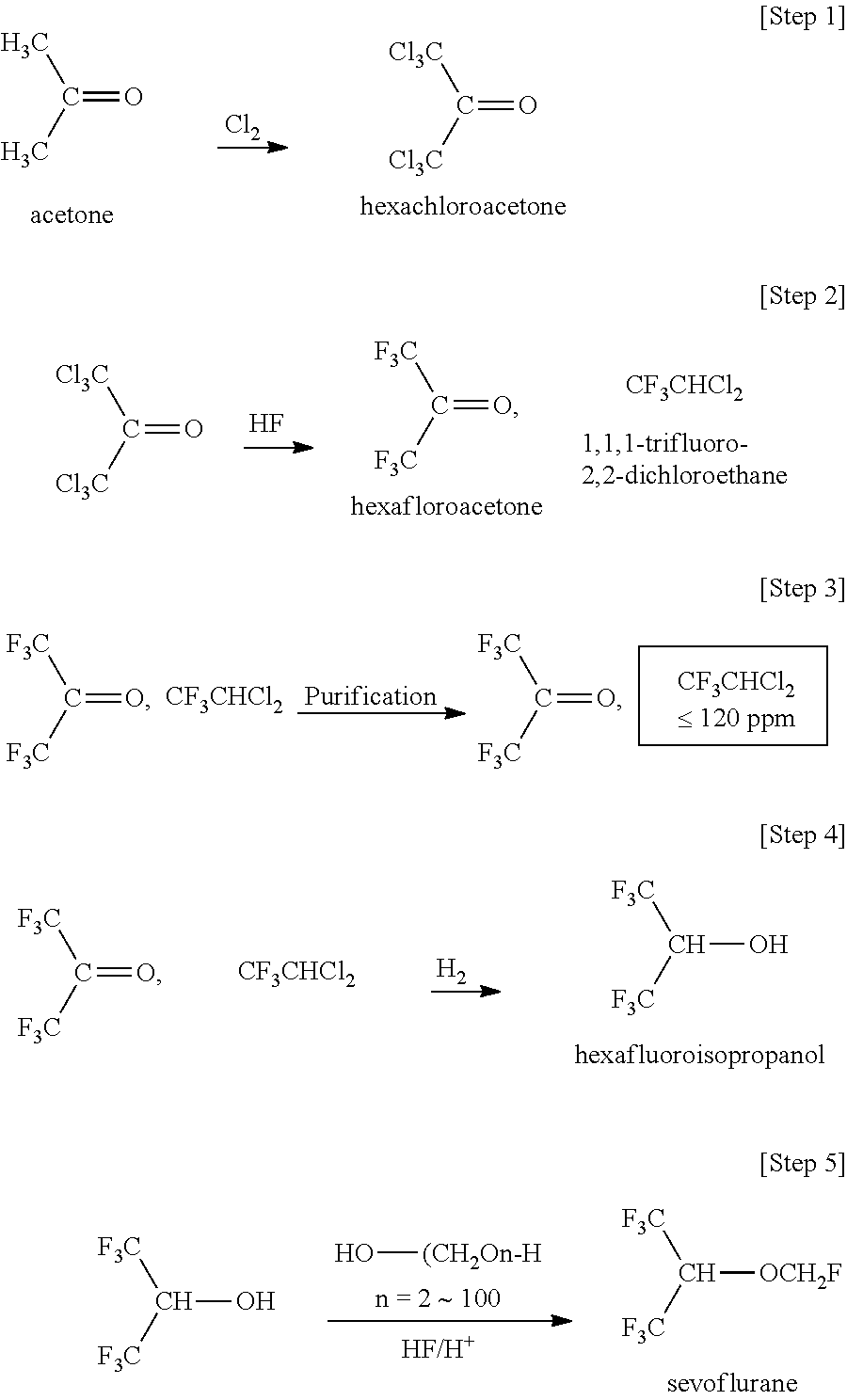Method for producing hexafluoroisopropanol and fluoromethyl hexafluoroisopropyl ether (sevoflurane)
a technology of hexafluoroacetone and hexafluoroacetone, which is applied in the field of producing hexafluoroisopropanol and fluoromethyl hexafluoroisopropyl ether (sevoflurane), can solve the problem that the reaction rate cannot be lowered, the phenomenon of the reaction progress, and the reaction rate cannot be reduced, so as to achieve the effect of preventing the reaction rate from lowering
- Summary
- Abstract
- Description
- Claims
- Application Information
AI Technical Summary
Benefits of technology
Problems solved by technology
Method used
Image
Examples
examples
[0202]The present invention is described in more detail with reference to Examples given hereinafter. However, the present invention is not limited to these. Here, “%” indicating compositional analysis values means “areal %” of the composition obtained by the measurement of a reaction mixture through direct gas chromatography (unless otherwise specifically indicated, the detector is FID). In Examples and Tables given hereinafter, “HCFC-123” represents “1,1,1-trifluoro-2,2-dichloroethane (CF3CHCl2)”, “TFIP” represents “1,1,1-trifluoroisopropanol”, “HFA” represents “hexafluoroacetone”, “HFIP” represents “hexafluoroisopropanol”, “TeFIP” represents “tetrafluoroisopropanol”, and “PFIP” represents “pentafluoroisopropanol”.
preparation example
[Preparation Example] Production of Hexafluoroacetone Trihydrate
[0203]300 g (5.17 mol) of acetone and 1.85 g (0.01431 mol) of quinolone were put into a 1-dm3 GL (glass lining) reactor equipped with a jacket. While 2262 g (31.90 mol) of chlorine gas was gradually blown thereinto, the reactor was gradually heated up to 185° C., and then stirred as such for a few hours. The resultant reaction liquid was distilled to give 1268 g (4.79 mol) of hexachloroacetone (purity 99.5%; chlorination reaction yield 92.6%; in addition to the acetone, a small amount of pentachloroacetone was detected, but the reaction liquid was directly used in the next fluorination step).
[0204]Subsequently, a chromium(III) oxide (Cr2O3) catalyst was put into a stainless steel reactor equipped with a jacket. 1268 g (4.79 mol) of the hexachloroacetone obtained in the above and 1013 g (50.65 mol) of anhydrous hydrofluoric acid were introduced thereinto by spending 40 hours to conduct a fluorination at 360° C. The obtai...
example 1
[0210]4.1 kg (18.63 mol) of hexafluoroacetone hydrate (trihydrate) [the composition of the hydrate and other impurities are shown in Table 2 below—the content of HCFC-123 before the start of the reaction is 119 ppm] was put into a 5-dm3 stainless steel (SUS-316) autoclave equipped with a stirrer. 0.195% by mass (% by mass relative to HFA hydrate—the same shall apply hereinafter) of 5%-Pd / alumina-supported catalyst (8 g), 0.122% by mass of 5%-Ru / alumina-supported catalyst (5 g), 0.122% by mass of aluminum hydroxide (5 g), and 0.0146% by mass of sodium hydrogencarbonate (0.6 g) were added thereto. The reactor was purged with hydrogen. Stirring was started with heating up to 95° C. with hot water, while the hydrogen pressure was kept at 0.7 MPa. With this, hydrogen absorption began.
[0211]After 12 hours, the reaction liquid was analyzed. With this, the HFA hydrate conversion was found to be 95.46%. Regarding the GC purity of HFIP was 94.76%, TFIP was 0.6275% and HFA was 4.54%.
[0212]Subs...
PUM
| Property | Measurement | Unit |
|---|---|---|
| Fraction | aaaaa | aaaaa |
| Fraction | aaaaa | aaaaa |
| Time | aaaaa | aaaaa |
Abstract
Description
Claims
Application Information
 Login to View More
Login to View More - R&D
- Intellectual Property
- Life Sciences
- Materials
- Tech Scout
- Unparalleled Data Quality
- Higher Quality Content
- 60% Fewer Hallucinations
Browse by: Latest US Patents, China's latest patents, Technical Efficacy Thesaurus, Application Domain, Technology Topic, Popular Technical Reports.
© 2025 PatSnap. All rights reserved.Legal|Privacy policy|Modern Slavery Act Transparency Statement|Sitemap|About US| Contact US: help@patsnap.com



